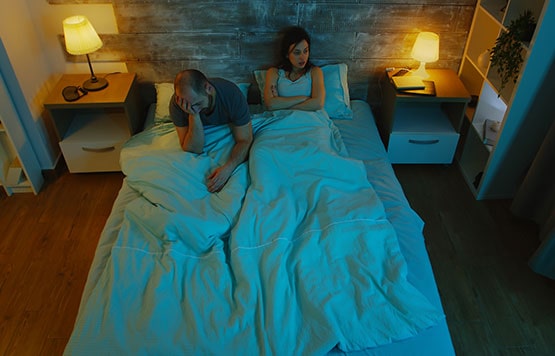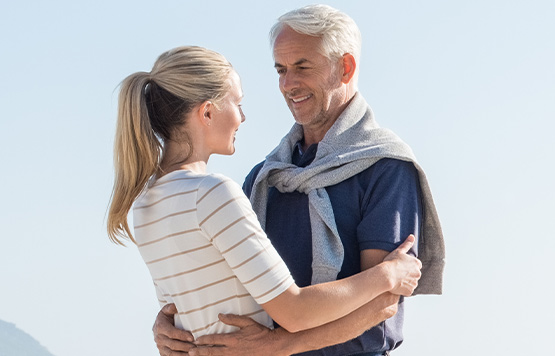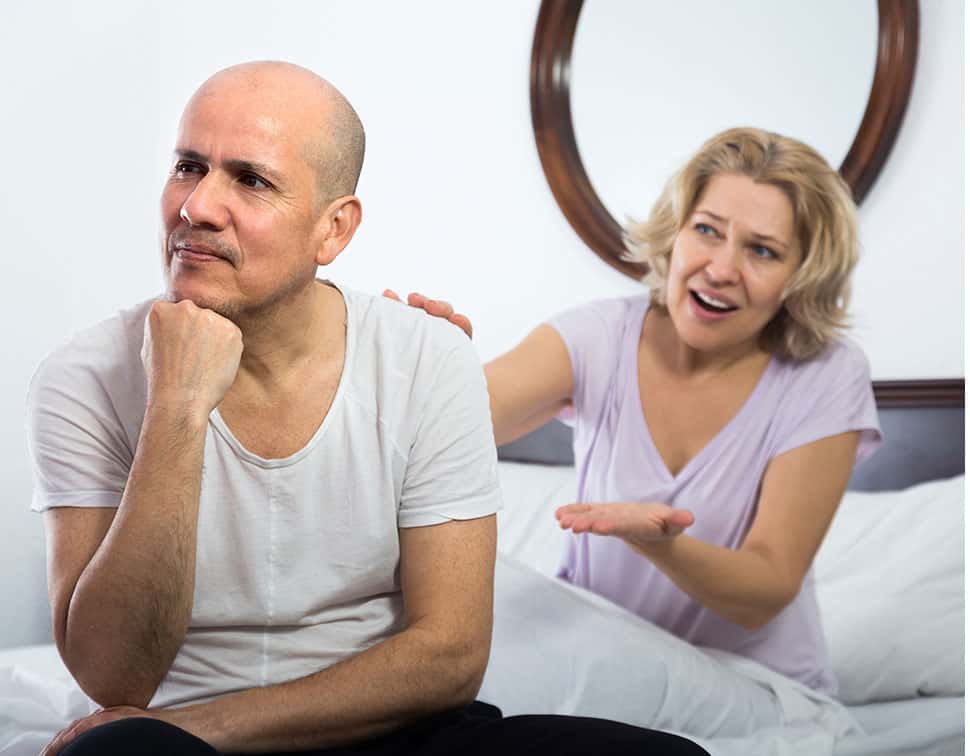We aren't guaranteed much as adults, but if there's one thing we can count on, it's that our bodies change as we get older. For men, that's especially true. One day you're lifting heavy weights and nailing your cardio regimen without having to stretch before or after. And then, in what seems like the blink of an eye, you start to slow down a little. You begin to notice aches and pains in places that weren't there before. You can't just go out for a night on the town, imbibe until your heart is content, and expect to wake up refreshed.
And while headaches and achy joints can be treated with ice and anti-inflammatory medicine, other aspects of aging aren't as easy to treat. You've probably guessed at this point what we're talking about: erectile dysfunction, or ED for short. When brought up to most men, those are two words that cause a guttural reaction of fear and trepidation.
While just about every man fears ED, millions suffer from it - almost 10% of the male population between the ages of 40 and 70. So, if you're beginning to have trouble performing in the heat of the moment, you're definitely not alone. You may be experiencing symptoms like:

Trouble Achieving an Erection

Trouble Maintaining an Erection

Lower Libido

Less Sexual Pleasure

Premature Ejaculation

Inability to Achieve Orgasm
However, at Elite Healthcare Physical Medicine, we understand that stats won't do anything to address the stress and anxiety you're facing in relation to erectile dysfunction. You need a viable solution - a science-backed treatment that doesn't require strange pills or invasive surgeries. As a fully integrated multidisciplinary clinic in Mount Pleasant, we have what you've been searching for: softwave therapy for ED in McClellanville, SC.

To fully grasp the benefits of using soft wave therapy for erectile dysfunction, you must first understand what causes ED to begin with. Put simply, erectile dysfunction is the inability to get an erection and keep it throughout sexual intercourse. You should know that it's not uncommon if you have erection trouble. However, if your inability to "get it up" becomes a common occurrence, you may be suffering from ED.
Erectile dysfunction doesn't just affect your penis - it also affects your wellbeing and relationships. It can lower your confidence, cause a large amount of stress that affects your ability to work, and may even cause contention with your partner.
You hear it all the time - as men get older, they often lose the ability to get erect. But why? As men age, the blood vessels in their penis start to fill up with micro-plaques, causing them to deteriorate. When these blood vessels deteriorate, it's more difficult for them to have steady blood flow. And that's the key to ED - having the constant blood flow to get and keep an erection. That's where the science-backed effectiveness of Softwave therapy swoops in to save the day.
Shockwave technology has been around for decades. It has been used at the highest-level research and medical facilities like the Cleveland Clinic and Memorial Sloan Kettering. However, Softwave therapy is a more refined, effective way to treat erectile dysfunction and also advance tissue healing.
Softwave therapy works by using electrohydraulic spark gap technology at its core. Its innovative design features a parabolic reflector applicator that produces very effective, low-intensity shock waves that are unfocused. Elite Healthcare Physical Medicine's Softwave applicator spreads energy to a large area of both superficial and deep tissue, creating a biological response that kickstarts your body's natural healing process.
For men suffering from ED, it is a revolutionary breakthrough treatment that doesn't require harmful surgeries or side effects from pills. In fact, it has been FDA approved for many uses, including improved blood flow, which is often the root cause of erectile dysfunction.
Book Appointment

Unlike some more traditional treatment options, Softwave therapy gets right to the crux of the ED issue. It uses shock wave technology on a cellular level, helping to naturally heal body parts, like the penis. Some of the most common benefits of Softwave therapy include:
Additionally, Softwave treatments don't require much prep, don't have any sketchy side effects, don't require any numbing agents or anesthesia, and result in little-to-no recovery time. Sound too good to be true? Contact Elite Healthcare Physical Medicine today to learn just how effective Softwave therapy is for our patients!

Softwave therapy works by using efficient, effective shock waves that cause biological regeneration processes that heal your body using its own healing factors. It works like this: Softwaves are created via a high-energy electrical discharge in water. The voltage is discharged between the plus and minus tips of an electrode. The spark gap or arching causes an equalization of voltage between the opposing tips of the electrode, which causes a hot plasma bubble. This bubble explodes and distributes in every direction, compresses the surrounding water, and generates a pressure > 10 MPa within nanoseconds.
To sum up, Softwave therapy uses low-intensity, unfocused energy that is delivered by a reflector in parallel waves. These waves help open up the blood vessels in your penis, allowing more blood to flow. At Elite Healthcare Physical Medicine, our team of expert physicians will develop a personalized Softwave therapy plan based on your body and needs. With the right number of treatments, you should be able to achieve and maintain firm erections as you did in your prime.

A Softwave therapy procedure averages 10-15 minutes but may be longer depending on treatment area and diagnosis. A gel is applied to the surface area to be treated. The applicator produces pulses as the clinician moves around the treatment area. During therapy, communication with your provider is necessary to identify treatment areas and monitor progress.
Once treatment is over, you may resume your normal day-to-day activities. In fact, most patients can have Softwave therapy while on their lunch break. You don't have to worry about recovery time, side effects, or any downtime at all.

More than 50% of men will experience erectile dysfunction at some point in their lives. If you're over the age of 30, have been suffering from ED, and don't want to rely on pills or surgery, Softwave therapy may be for you. That's doubly true if you've tried traditional treatments like Viagra and even surgery but didn't get the results you hoped for. Many academic studies about shockwave therapy for ED state that this revolutionary technology is successful where PDE5 inhibitors fail.
In fact, many urologists consider Softwave therapy the most promising ED treatment on the market. The truth is, even if you're not battling ED, men can use Softwave therapy as a preventative way to keep the magic flowing in the bedroom. Some of the key reasons to choose Softwave therapy over less effective, traditional treatments include:
If you're curious why Softwave treatments are so popular for ED, the answer is simple. Prescription drugs like Cialis and others that "treat" ED often come with less-that-savory side effects. At best, these effects are just something patients have to deal with. At worst, they can disrupt your day-to-day schedule and may prevent you from enjoying a healthy life. Sure, some men swear by the "little blue pill," but most guys aren't aware of the hidden risks with drugs like Viagra. The following side effects can be common in both short and long-term circumstances:
If you're suffering through erectile dysfunction, it's crucial to understand why it's happening. The primary reason for ED is a lack of blood flow to the penis, which makes erections difficult to get and keep. Rather than relying on prescription and gas station pills for a quick fix, more men are using softwave ED treatment in McClellanville, SC for an all-natural solution minus the side effects. With Softwave therapy, you don't have to live with ED, and you don't have to suffer from scary side effects from popping too many pills.
Book Appointment
Softwave therapy is often a more effective solution for men with ED than similar but less effective treatments using pressure waves. Softwave therapy from Elite Healthcare Physical Medicine uses acoustic pulses or unfocused shockwaves with fast and steep rise times and high positive pressure. Our unfocused wave design makes it possible to spread energy to a larger area, which affects deep and superficial tissue. By targeting a larger area, a more potent biological response is often achieved, initiating your body's natural healing factors.
By comparison, radial pressure waves use acoustic pneumatic pulses with low steeping effects, slow rise times, and large negative pressures. Radial waves are shallower than the shockwaves used in Softwave technology and focus energy and pressure at the surface of the applicator.
Here's a quick breakdown of the differences between softwave therapy for ED in McClellanville, SC, and radial pressure waves:

If you're new to the world of Softwave therapy, chances are you've got some lingering questions you need answered. We'll do our best to answer a few of those questions here for your convenience.
Q. Has the FDA approved softwave therapy for ED in cityname, state?
A. Yes - Softwave therapy is FDA 510(k) approved for:
Q. Is softwave therapy painful?
A. Softwave therapy does not require surgery or any invasive form of treatment. With that said, some patients describe minimal discomfort or pain during our softwave treatments. Should this occur, your medical specialist will make necessary adjustments. Usually, patients do not have to endure any pain at all and only experience a pulse or tapping feeling on their skin.
Q. How long is a Softwave treatment session?
A. An individual session only takes five to fifteen minutes. It's typically recommended that patients have treatment once a week for three to five weeks. The length and frequency of your Softwave therapy sessions will be determined after you visit our medical clinic for a comprehensive evaluation.
Q. How long does it take for Softwave therapy to work?
A. Every patient we treat is different, and as such, will have different treatment recommendations. Often, patients notice the results of Softwave therapy after the first session. However, for the longest-lasting effects, most patients need between three and four treatments, with a week of non-treatment after every session.
Q. Can I combine Softwave therapy with other treatments from Elite Healthcare Physical Medicine?
A. It's hard to give a definitive answer to this question since every patient is different. It's important for you to have a full evaluation to determine the scope of your needs and the appropriate therapies. However, Softwave therapy often works very well with other treatments. In fact, other therapies offered at our medical clinic like massage therapy and chiropractic care can make Softwave treatment even more effective.
Remember - our team at Elite Healthcare Physical Medicine is always happy to answer any questions you may have about ED or our ED treatments. Give us a call today - it would be our pleasure to get to know you better!
Unlike some wellness clinics, our experienced providers work together to optimize treatment for men suffering from ED. We always strive to make sexual wellbeing an accessible part of your everyday lifestyle.
That's why, at Elite Healthcare Physical Medicine, our mission is simple: to correct the root cause of your erectile dysfunction by taking a comprehensive, total body approach to healing and treatment. We want to address your ED problem without having to resort to chemical-based medications or unnecessary surgeries. Instead, we focus on all-natural, effective solutions like shockwave therapy for ED in McClellanville, SC.
By discovering what's best for each person's individual body and needs, we can help create a healthier future for those in our community through our holistic physical medicine practices. Contact our office to learn more about Softwave therapy and how we can solve the underlying causes of your unique ED situation.
Book AppointmentLast fall, we urged Charleston County zoning officials not to allow a new sand mine operation on 20 acres next door to the St. James Santee Elementary-Middle School, and our call — along with the voices of several school officials and neighbors — was heard when the county deferred the request. Now that the proposal has returned in a slightly improved but still potentially harmful form, we repeat our request to reject the mining operation and urge others to do the same.We also repeat our call to state regulators to step up ...
Last fall, we urged Charleston County zoning officials not to allow a new sand mine operation on 20 acres next door to the St. James Santee Elementary-Middle School, and our call — along with the voices of several school officials and neighbors — was heard when the county deferred the request. Now that the proposal has returned in a slightly improved but still potentially harmful form, we repeat our request to reject the mining operation and urge others to do the same.
We also repeat our call to state regulators to step up efforts to bring South Carolina’s outdated mining laws up to date. This proposed sand mine is but one of many such operations that have triggered serious concerns about their impact on neighbors’ health and quality of life.
Charleston County’s Board of Zoning Appeals will meet at 4:30 p.m. Monday to consider a special exception for the sand mine off U.S. Highway 17 on a wooded tract just across Lofton Road from the St. James Santee school. While the request has been changed so that sand-laden dump trucks no longer would access U.S. 17 via Lofton, the operation still would create noise, vibration, dust and other problems for the school, which sits less than 1,000 feet away.
About 20 trucks are expected to come and go daily from the mining site, which is also about a half mile from the Francis Marion National Forest.
The county’s own analysis has suggested the mining site could mar land with soil types that the U.S. Department of Agriculture considers the best for agricultural production. The county’s comprehensive plan notes that “Designation of farmland preservation areas recognizes the importance of preserving Charleston County’s farming resources, including individual farms and areas of productive soils, as well as a way of life valued by the community,” and county staff says this mining use may not be consistent with the plan. The staff also notes its proximity to the school may make the mine harmful to the welfare and character of the immediate community.
The Coastal Conservation League’s Riley Egger tells us that while the new access road is a positive concession, “it does not alleviate our concern about the appropriateness of the mine site.” We urge others with similar concerns to email them to bza@charlestoncounty.org by noon Friday.
The looming controversy over a sand mine on Lofton Road points to a greater challenge that South Carolina must still grapple with: updating its mining law and regulations to make them appropriate for the 21st century, particularly as once-rural parts of our state are developing or being valued as conserved parks and lands. There are places where new mines are appropriate, but there are also places — such as neighborhoods, schools and public lands — that need to be protected from these new light industrial operations opening up next door. Our state isn’t the same largely rural place it was in the 1970s, when the current regulatory playing field for mining operations was designed.
The state Department of Health and Environmental Control has recently worked with a newly formed Mining Task Force, which includes mining companies and conservationists. We urge all involved to get back to the table and produce recommendations that lawmakers can consider next year. Our coastal communities are seeing how a growing demand for sand and fill leads to dusty highways, unwelcome discharges, blight and a scarred landscape with ponds of limited use. Berkeley, Charleston and Dorchester counties alone have had about 100 active sand mining operations in recent years.
Rejecting the Lofton Road sand mining proposal would be an important step to protect the St. James Santee Elementary and Middle School, but until the state updates its outdated mining law, such zoning controversies will continue to take up more of our time that could better be spent somewhere else.
Click here for more opinion content from The Post and Courier.
Known for its lovely weather, sandy beaches, and refreshing natural activities, South Carolina is an amazing state filled with particular towns featuring amazing historical, cultural, and natural sights. Aisles of delightful pastel-colored houses, mesmerizing waterfront views, and the delectable classic Southern supper shape the soul of these welcoming communities. The "Palmetto State" has settlements of all shapes and sizes, ...
Known for its lovely weather, sandy beaches, and refreshing natural activities, South Carolina is an amazing state filled with particular towns featuring amazing historical, cultural, and natural sights. Aisles of delightful pastel-colored houses, mesmerizing waterfront views, and the delectable classic Southern supper shape the soul of these welcoming communities. The "Palmetto State" has settlements of all shapes and sizes, from harbor towns to mountain hamlets to modern villages. If you seek a relaxing stroll through a green natural park, like Trailblazer Park in Travelers Rest, an adrenaline-rich paddleboarding adventure on Prestwood Lake near Hartsville, or a limitless Oktoberfest celebration in Walhalla, these unique South Carolina villages got you covered. So, take a moment to behold this all-American land laden with green natural scenery and festivals — South Carolina is waiting for you!
Turning your back to the Atlantic Ocean, McClellanville is where fishing, oystering, and shrimping are not just business but a way of life. The dense Francis Marion National Forest surrounds this small fishing town and grants a misty landscape usually found only in fairy tales. McClellanville has traditionally relied on the Atlantic Ocean and the coastal marshes for seafood provisions, which play a dominant role in the town's economy. The first store opened soon after the Civil War. Today, one can find many behind the ship masts. If one seeks to taste the fruit of the fishers' labor, T W Graham & Co provides a great selection of seafood dishes spanning from muscles to fried shrimps paired with scallops and french fries.
Travelers Rest enjoys the southern foothills of the Blue Ridge Mountains in South Carolina's magnificent Upcountry region. This cozy getaway once served as a hiding spot for the Lowcountry travelers who traveled through the highlands from the hot summer days. Those journeymen did not use highways but instead walked along iconic trails like the unique Bunched Arrowhead Heritage Preserve loop. Surrounded by the green forest, this trail still feels like a blast from the past, stepping where those journeymen once walked, and is popular with many tourists. Visitors to Travelers Rest can spend quality time at Trailblazer Park, where the green space is replete with fun attractions like a live music stage, food gazebos, car shows, and occasional movie projections.
Amidst the rolling hills and pastureland near the North Carolina border, Landrum boasts breathtaking natural wonders. Landrum ensures a warm and inviting atmosphere that will enhance your visit to this town. The nearby Chestnut Ridge Heritage Preserve provides many hiking trails, charming waterfalls, and stunning vistas belonging to story books. Spanning across Beaverdam Creek, the iconic Campbell's Covered Bridge with its red-colored wood goes in pendant with the fall foliage of the surrounding trees. Hikers will find the Palmetto Trail at the 575-acre Blue Wall Preserve very stimulating, with its scenic paths along Lanny's Falls past the twin ponds. Staying in town, downtown Landrum has plenty of artsy shops, boutiques, welcoming eateries, and antique shops like Landrum Eclectics, a Beautiful home full of antique and vintage pieces that warmly welcomes every customer.
York combines urban charm and small-town tranquility, where the nearby James Ross Wildlife Reservation forest quietly infiltrates the settlement. The town maintains a deep reverence for its history, which is showcased through its beautifully preserved historic district. One can admire the splendidly unique 19th-century buildings in the downtown area or explore one of the many museums. For example, the Museum of York County is a heritage museum that grants a naturalist center with hands-on programs and tells the story of York County. Moreover, York boasts a collection of historical landmarks highlighting its importance in American history. Among these is the McCelvey Center, an esteemed establishment listed on the National Register of Historic Places. The nearby Kings Mountain State Park provides the perfect setting for activities such as camping, hiking, or simply enjoying the natural heaven that surrounds you.
Walhalla overlooks the reaching shores of Lake Keowee near the Georgia border. Home to 4,072 hard-working people, Walhalla's community is known for its incredible natural scenery and its German heritage. German immigrants who sought refuge from the German revolutions of the mid-1800s settled here and named the town after "Valhalla" from Norse Mythology. Thanks to the prevalent German culture, the town also holds a massive annual Oktoberfest celebration with thousands of beer pints.
Besides the town's German history, there is a lot more to discover at places such as the Museum of Cherokee. This museum showcases South Carolina's Cherokee Native American heritage through artifacts, pottery, and texts. One of the most popular attractions is Issaqueena Falls, a beautiful rocky waterfall. The view of this amazing cascade is accessible only by its namesake trail and is one of the most unique sites to visit in the state! Visiting Walhalla will be just like entering the Nordic heaven.
Georgetown is the third oldest city in the state of South Carolina and the second-largest seaport. Part of what makes Georgetown unique is its beautiful historic homes, adorned with gracious porches, shaded, live-oak canopies, and sparkling waterways. Georgetown is easy on the eyes and provides distinct natural beauty. Georgetown has over 50 antebellum mansions in and around its downtown district, with some rumored to be haunted by ghosts, demons, and other entities. If you are into spooky tours, feel free to join the unique Ghosts of Georgetown lantern tour for a shivering experience through town.
For nature lovers, the Tom Yawkey Wildlife Center Heritage Center grants visitors an eye-watering 24,000 acres of pristine nature and hosts hundreds of animals, including American alligators and loggerhead sea turtles. Strolling along the town's scenic Harborwalk, one might find some of Georgetown's fine eateries. For example, Soco Grille delights customers with its juicy brisket and wide selection of seafood offerings.
Prestwood Lake bounds the small town of Hartsville, creating a fantastic ambiance. Hartsville combines a collection of cultural attractions and a wide range of natural wonders. When it comes to nature, Hartsville houses many gorgeous gardens and parks filled with scenic views, such as the Kalmia Gardens, which displays 30 acres of floral biodiversity and is a great place to start your Hartsville journey. Another must-see attraction is the Hartsville Museum, an old 1930s post office that has been repurposed into a home for history and art. This museum also boasts historical movie exhibits, a sculpture garden, and a mural featuring the town's first commercial studio. For outdoor lovers, the nearby Prestwood Lake grants 280 acres of water sports fun, a perfect setting for swimming, kayaking, or even paddleboarding. For a more relaxing experience, the Hartsville Memorial Library is a great place to relax and wind down. This library was established in 1920 and has hundreds of books on display, as well as magazines and even historic newspaper prints.
South Carolina is a stronghold of that unique old-school American charm, and its small towns are proof that pairing natural beauty with historical legacy is an excellent match. From the small fishing town of McClellanville with its ever-crowded port to the splendidly restored 19th-century buildings in downtown York or the sweeping Tom Yawkey Wildlife Center Heritage Center with its free wildlife near Georgetown, South Carolina's communities are eager to show their peculiarity and charm with travelers of all origins. Each of these towns serves as a refuge of curiosities and provides a peaceful ambiance in their unique way.
It has now been 34 years since Hurricane Hugo devastated much of the coast of South Carolina.What You Need To Know Hugo was a Category 4 hurricane with estimated sustained winds up to 140 mph when it came inland during the early morning hours of Sept. 22, 1989, near McClellanville, S.C.Hugo produced a 16-foot ...
It has now been 34 years since Hurricane Hugo devastated much of the coast of South Carolina.
Hugo was a Category 4 hurricane with estimated sustained winds up to 140 mph when it came inland during the early morning hours of Sept. 22, 1989, near McClellanville, S.C.
Hugo produced a 16-foot storm surge in McClellanville. A high school in the small coastal town had been selected as a shelter because maps showed it was at an elevation of 20 feet. It was actually just 10 feet above sea level, and six feet of seawater rushed into the school, where around 400 people were seeking shelter.
Eyewitness accounts say people became trapped and climbed on top of tables and chairs to avoid drowning.
Wind gusts up to 108 mph occurred in nearby Charleston, damaging around 80% of roofs in the city. Over 100 buildings in Charleston were severely damaged or destroyed.
Along the North Carolina coast, Hugo damaged at least 25 beachfront homes at Holden Beach and completely washed away seven to eight-foot dunes. The storm also destroyed a 50-foot section of the Carolina Beach pier.
Hugo did not only impact coastal areas. The storm produced hurricane-force winds as it moved over Charlotte.
Wind gusts in the Queen City reached up to 100 mph. Around 85% of the city lost power. Windows from skyscrapers in Uptown were blown out and came crashing down on nearby streets.
Hickory reported a gust of 85 mph.
There were numerous downed trees and widespread power outages across the western Piedmont and Foothills of North Carolina.
Heavy rain led to flash flooding in the northern mountains. Mount Mitchell recorded over 8 inches of rain from the storm.
According to the State Climate Office of North Carolina, seven to 12 deaths were attributed to the storm in North Carolina. That included a 6-month old child in Union County who was sleeping when a tree fell on his home.
Our team of meteorologists dives deep into the science of weather and breaks down timely weather data and information. To view more weather and climate stories, check out our weather blogs section.
Anglers and fish alike can enjoy an expanded CCA-McClellanville Reef (PA-34) as of this week.On Tuesday, March 9, South Carolina Department of Natural Resources (SCDNR) and Coastal Conservation Association South Carolina (CCA SC) staff took advantage of calm seas and beautiful weather to add a retired tugboat and 24 four-foot diameter concrete culvert pipes concrete culvert pipes to the existing artificial reef in 50 feet of water. The tugboat and culverts joi...
Anglers and fish alike can enjoy an expanded CCA-McClellanville Reef (PA-34) as of this week.
On Tuesday, March 9, South Carolina Department of Natural Resources (SCDNR) and Coastal Conservation Association South Carolina (CCA SC) staff took advantage of calm seas and beautiful weather to add a retired tugboat and 24 four-foot diameter concrete culvert pipes concrete culvert pipes to the existing artificial reef in 50 feet of water. The tugboat and culverts joined numerous other structures that form the reef, including remnants of the former Cooper River Bridge, concrete structures and a 105' tugboat. The new reef additions were funded in part by CCA SC and in part by funds provided through the purchase of saltwater fishing licenses. "The Coastal Conservation Association has been a tremendous help to us in getting high-quality material distributed along our coast," said SCDNR artificial reef coordinator Bob Martore. "Vessels like this provide an excellent foundation for a reef community because their complexity attracts a wide variety of species."
Artificial reefs play a similar role as coral reefs, which cannot grow in the temperate waters off the coast of South Carolina. These human-built structures are typically placed on areas of seafloor with little natural relief, improving habitat and spawning grounds for a diverse array of fish and marine life – and in turn attracting recreational divers and anglers.
"Today's deployment marks another fantastic collaborative effort between the conservation community, private industry, and state government that benefits both fish and fishermen" said Scott Whitaker, CCA SC executive director. "Enhancing habitat and expanding access for recreational anglers are two of the cornerstones in CCA SC's coastal initiative plan and we are excited about the additional projects planned for 2021 and beyond."
SCDNR has been constructing artificial reefs to improve offshore fish populations and recreational opportunities for over forty years, sinking everything from bridge spans to military vehicles to subway cars. The environmental benefits of artificial reefs are twofold, as they recycle materials that would otherwise be destined for landfills in addition to expanding critical habitat for offshore fish. Structures intended for artificial reefs undergo a long and rigorous cleaning process to ensure they're safe to sink.
South Carolina is home to dozens of artificial reef sites, the location data for which are free to download to your marine GPS device.
Lindsay is a working mother in McClellanville, South Carolina, and like many people living in rural communities, lacking access to reliable, high-speed internet used to be a challenge that affected her entire family.“Especially when the kids came home from school, and I was still working, I would have to be like, ‘nobody get on a tablet, nobody stream videos’… Even the kids had to wait to do their homework on their computers, because if there was one other device besides my computer using the internet, it woul...
Lindsay is a working mother in McClellanville, South Carolina, and like many people living in rural communities, lacking access to reliable, high-speed internet used to be a challenge that affected her entire family.
“Especially when the kids came home from school, and I was still working, I would have to be like, ‘nobody get on a tablet, nobody stream videos’… Even the kids had to wait to do their homework on their computers, because if there was one other device besides my computer using the internet, it would bring me down.”
It felt like an untenable way to live in the modern, connected world. That is until Home Telephone Company, with an assist from USDA Rural Development’s ReConnect Program, stepped in to extend high-speed internet services to several areas of Berkeley County, Dorchester County, and portions of the Greater Charleston area, of which McClellanville is included. And in Lindsay’s words, “It’s been a game-changer.”
“We have multiple devices, and everybody’s always running something. We’ve never had a glitch or interruption in service. It’s been beyond superior to what we had.”
Rural Development provided a $8,184,531 grant to fund the project. Home Telephone Company matched this funding for a total of $16,369,063. This enabled Home Telephone Company to extend fiber optic cable over 153 square miles, connecting 3,780 households, 19 educational facilities, eight critical community facilities, and families like Lindsay’s, to high-speed internet in the process.
Rural Development’s ReConnect Program furnishes loans and grants to provide funds for the costs of construction, improvement, or acquisition of facilities and equipment needed to provide high-speed internet service in eligible rural communities. Find out if ReConnect can do for your community what it did for the people in Orangeburg: https://www.usda.gov/reconnect.
Date of Obligation
Fri, 11/15/2019 - 16:05
Tue, 10/25/2022 - 10:41
Obligation Amount:
$8,184,531
Date of Obligation:
Congressional District:
Where can Iowans find some of the fastest internet service in Iowa? How about in three rural communities in the western part of the state that have a total population of just 962 residents. Residents in and around the communities of Breda (pop. 483) and Lidderdale (pop. 180)… [Read More]
